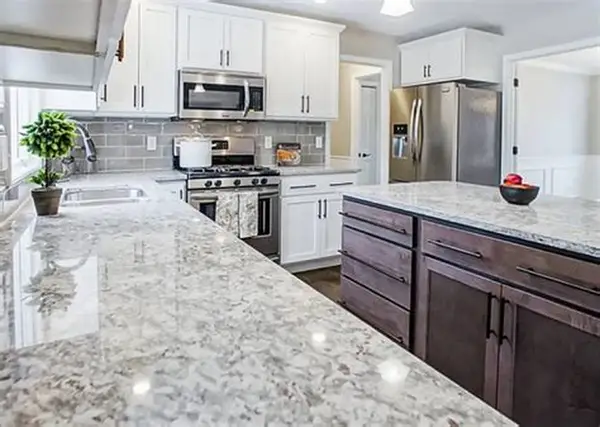
If you’re considering granite countertops—or you already have them—you’ve probably heard two conflicting claims: “granite doesn’t stain” and “granite stains easily.”
If you’re considering granite countertops or you already have them—you’ve probably heard two conflicting claims: “granite doesn’t stain” and “granite stains easily.” The reality sits in the middle. Granite is a tough, long-lasting natural stone that can resist most daily messes, but because it’s slightly porous, it can stain without proper sealing and care. This guide explains exactly why stains happen, how to prevent them, and how to remove even the stubborn ones—while weaving in practical design and maintenance tips for granite kitchen countertops and granite bathroom countertops.

Why a Strong Stone Can Still Stain
Granite is formed from interlocking crystals (mostly quartz, feldspar, and mica). Those mineral grains give the surface its legendary hardness and beauty—from black granite countertops with inky uniformity to dramatic white granite countertops with bold veining, warm brown granite countertops, and shimmering blue pearl granite countertops. But in between those grains are microscopic pores. Liquids can linger there unless you protect the surface.
- Porosity varies by slab. Dense, dark stones (many blacks) often absorb less moisture than light or highly variegated stones.
- Finish matters. Polished granite countertops have a tighter surface and generally resist stains better than honed granite countertops (matte), which can show fingerprints, water spots, and oils sooner.
- Location & use matter. Granite bathroom countertops see cosmetics and hard water; kitchen countertops meet oil, wine, coffee, and tomato sauce—prime staining agents.
Bottom line: Granite can stain, but with the right sealer and simple habits, it’s easy to keep your counters looking new.

The Top Culprits: Common Granite Stains & What They Look Like
Understanding the type of stain you’re dealing with makes removal faster and safer.
- Oil-based stains (cooking oil, butter, salad dressing): Dark, shadowy patches that don’t evaporate. Most common in best granite countertops for kitchens where cooking is frequent.
- Organic stains (coffee, tea, wine, tomato, fruit): Brownish or pinkish halo; often more visible on white granite countertops.
- Hard-water/mineral deposits (bathrooms & around sinks): Dull, chalky rings or film; more noticeable on black granite countertops.
- Rust/iron (from metal cans or tools): Yellow/orange discoloration, sometimes in a circular footprint.
- Soap film & etching look-alikes: Granite doesn’t etch from mild acids like marble does, but soap scum and cleaner residue can create a cloudy appearance that mimics etching.
Pro tip: Before treatment, confirm it’s a stain (absorbed) versus residue (sitting on top). If a damp microfiber pass improves it, start with residue removal.
Prevention First: Everyday Habits That Stop Stains
- Seal on schedule. Quality impregnating sealers fill micro-pores and buy you time to wipe spills. (More on frequency below.)
- Blot, don’t wipe. For spills, blot toward the center so liquids don’t spread.
- Use boards, coasters, and trivets. Stain prevention + scratch and heat insurance.
- pH-neutral cleaners only. Skip vinegar, bleach, and abrasive powders. A stone-safe daily spray preserves the sealer and the finish.
- Dry the sink deck. Prevent hard-water film (especially on black and dark tones).
Want a quick bathroom add-on? Here’s a handy resource on keeping fixtures spotless: How to Clean a Black Granite Sink.
Do Dark or Light Granite Countertops Stain More?
- Dark / Black: Often less porous; they tend to hide marks but show hard water and soap residue. Daily microfiber drying keeps them jet-black.
- White / Light: More likely to absorb colorful spills, so sealing matters more. The upside? They don’t show water rings as easily.
- Brown & earth tones: Middle of the road—still benefit greatly from sealing, especially if honed.
How Often Should You Seal Granite?
There’s no one-size-fits-all schedule. Use the water drop test: place a teaspoon of water on the counter; if it darkens the stone in under 10 minutes, it’s time to reseal. Many kitchen slabs do well with annual sealing; darker, denser stones may stretch to every 18–24 months, whereas honed finishes or high-traffic areas may need more frequent attention.
If you’re weighing care needs against alternatives, see: Do You Need to Seal Granite Countertops?.
Step-by-Step: Removing Stains on Granite Countertops
1) Start Gentle: Remove Residue
- Mix a few drops of mild dish soap with warm water.
- Wipe with a microfiber cloth; rinse and dry thoroughly.
- For hard water, use a stone-safe scale remover or a 50/50 isopropyl alcohol + water spritz, then wipe dry.
2) Treat the Stain Type
Oil-Based (dark wet-look spots)
- Make a poultice: blend baking soda with water to peanut-butter thickness.
- Spread 1/4″ thick over the stain; cover with plastic wrap and tape edges.
- Let dry 24–48 hours; remove and rinse. Repeat if needed.
Organic (coffee, wine, tea, tomato)
- Same poultice method but swap water for 3% hydrogen peroxide (test first on a hidden spot).
- For stubborn marks, alternate cycles with stone-safe oxygen cleaners.
Rust
- Use a stone-approved rust remover (avoid generic rust gels not labeled safe for natural stone). Follow label precisely; rinse well.
Ink/Colorant
- For light granite: a small amount of hydrogen peroxide on a cotton pad; for dark granite: acetone may work (spot test first). Finish by cleaning and drying.
After successful stain removal, reseal that area to restore uniform protection.
Are Granite Countertops Heat Resistant?
Yes—granite countertops are heat resistant, which is one reason they remain a favorite in busy kitchens and even granite countertops for outdoor kitchens. Still, do use trivets: intense, localized heat can weaken sealer or (rarely) shock the stone at fissures. Good habits preserve both pros and cons of granite countertops in your favor.
Daily & Weekly Care Plan (That You’ll Actually Keep)
- Daily: pH-neutral stone cleaner; microfiber dry around sinks.
- Weekly: Quick check for darkened areas or film; address immediately.
- Quarterly: Re-do the water drop test in high-use zones.
- Annually: Plan your how to seal granite countertops session (or book a pro if you prefer).
For heavy countertops, safe handling during any service matters—see the Aardwolf Forklift Boom (for trade pros and fabricators) here: Forklift Boom FB1-2720.
And discover pro tools and tips at Toolrange Asia.
Granite vs. Quartz: Which Stains Less?
In the granite vs quartz countertops debate, engineered quartz is non-porous and generally more stain resistant out of the box. Granite demands sealing—but rewards you with unique movement, depth, and heat tolerance. Many homeowners blend both across spaces: quartz in utility areas, granite as the focal point on an island.
Buying, Installing & Maintaining Granite: Smarter Choices
Whether you’re shopping granite slabs for countertops, planning custom granite countertops, or comparing granite countertop installation services, factor in maintenance:
- Ask for the stone’s absorption rate and whether it’s polished or honed.
- Request a factory or fabricator seal on install day.
- Clarify aftercare: recommended cleaner, sealer brand, and reseal interval.
- Searching granite countertops near me or granite countertops in [city name]? Visit a granite countertop showroom [location] and compare sealed test pieces side by side.
Budget tip: If price is key, look into where to buy granite countertops at wholesale prices or ask wholesale granite countertops suppliers about remnant programs for vanities and laundry rooms.
Troubleshooting at a Glance
| Issue | Likely Cause | Quick Fix | Prevent Next Time |
|---|---|---|---|
| Dark spot around cooktop | Oil splatter absorbed | Baking soda + water poultice | Seal and use splatter guard |
| Cloudy film near faucet | Hard water/soap residue | Stone-safe scale remover; microfiber dry | Wipe dry after use |
| Pinkish halo on light stone | Wine, coffee, tomato | Baking soda + 3% peroxide poultice | Coasters; blot spills ASAP |
| Rust circle from can | Metal oxidation | Stone-safe rust remover | Keep metal off damp stone |
| Fingerprints on honed black | Natural oils | pH-neutral cleaner; buff dry | Consider re-finishing or enhancing sealer for honed surfaces |
FAQs About Staining & Granite Countertops
Do sealed granite countertops still stain?
A good sealer dramatically slows absorption, giving you time to wipe spills. But no sealer makes stone “bulletproof.” Renew the sealer as needed.
Will baking soda scratch granite?
Used as a paste (not a dry scour), baking soda is generally safe. Always apply with a soft cloth and rinse well.
Can I use bleach or vinegar?
Avoid both. Harsh or acidic cleaners can degrade sealers and leave the surface dull. Stick to stone-safe, pH-neutral formulas.
What about outdoor kitchens?
Choose denser stones and seal more often due to exposure. Ask local granite countertop installers near me for climate-specific care.
Final Verdict: Yes, Granite Can Stain—But It’s Easy to Prevent
With sensible sealing and everyday habits, granite countertops deliver decades of beauty and performance in kitchens and baths. They’re heat-tolerant, naturally unique, and—when maintained—remarkably forgiving. If you’re ready to install, refresh, or build an affordable granite countertops for modern kitchens plan, pair the right stone with the right care and you’ll rarely worry about stains again.
Helpful Resources & Anchor Links
- Professional tools & tips for the trade: Toolrange Asia
- Material handling attachment for pros: Aardwolf Forklift Boom FB1-2720
- Bathroom care companion: How to Clean a Black Granite Sink
- Care planning: Do You Need to Seal Granite Countertops?

